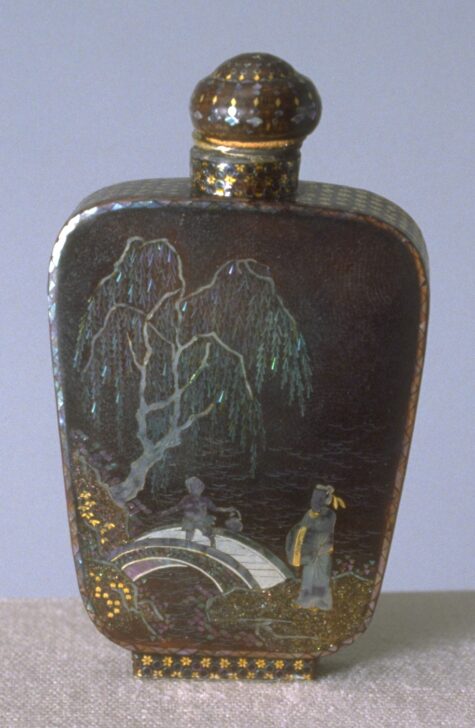Lacquer burgaute snuff bottle
Chinese

Description
Subject Matter:
Laque burgauté, also spelled Lac Burgauté, in the decorative arts, East Asian technique of decorating lacquerware with inlaid designs employing shaped pieces of the iridescent blue-green shell of the sea-ear (Haliotis). This shell inlay sometimes engraved and occasionally combined with gold and silver. Workmanship is exquisite; therefore, laque burgauté is principally used to decorate such small-scale objects as tiny boxes, miniature tablescreens, vases, and especially little silver-lined wine cups, usually made in sets of five.
em>Laque burgauté seems to have originated in China, with examples occurring as early as the Ming dynasty (1368–1644), and was especially popular in the Ch'ing dynasty(1644–1911/12), when it was also used to cover unglazed porcelain. It was widely used by Japan craftsmen in the Tokugawa (Edo) period (1603–1867). In China this technique is referred to as lo tien, and in Japan it is called aogai. Like many of the artistic techniques and objects imported into 17th- and 18th-century Europe from eastern Asia, the Western name is derived from the French—sea-ear (burgau) lacquer (laque,or lac).
https://www.britannica.com/art/laque-burgaute
Physical Description:
Lacquer burgaute snuff bottle with the design of a willow tree hanging over a bridge with a child walking over it and a man dressed in robes waiting on the other side.
Usage Rights:
If you are interested in using an image for a publication, please visit https://umma.umich.edu/request-image/ for more information and to fill out the online Image Rights and Reproductions Request Form.